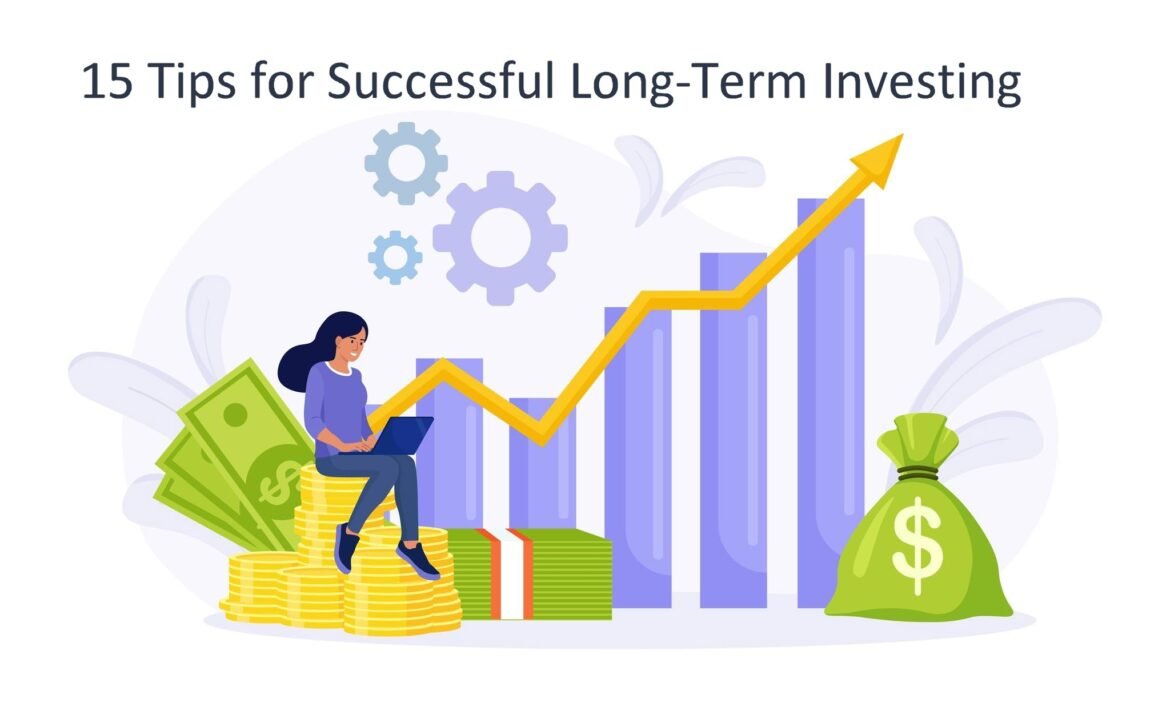15 Tips for Successful Long-Term Investing
Investing for the long term is a smart way to build wealth, but it requires patience, strategy and discipline. While many investors focus on quick wins, successful long-term investors understand the importance of stability, consistency and research. Below are 15 key tips to help you create a strong foundation for long-term investing and maximize your returns over time.
—
1. Avoid timing the market
Trying to time the market is one of the biggest mistakes investors can make. Many believe they can consistently buy low and sell high, but in reality, even experts cannot predict the market with precision. Instead, adopt a long-term strategy and stay invested through market cycles. Focus on steady growth over time rather than reacting to daily market movements.
2. Diversify Your Portfolio
“Putting all your eggs in one basket” is an essential mantra for successful investing. Diversification helps reduce risk by spreading investments across different sectors, asset classes and markets. By having a balanced mix of stocks, bonds, property and even international investments, you can protect your portfolio from volatility in a single market.
3. Understand the Importance of Dividend Stocks
Dividend stocks provide stable income and are an excellent choice for long-term investors. Reinvesting dividends can increase your return over time. Look for companies with a strong history of dividend payments and a solid financial outlook. Dividend-paying stocks are especially valuable during market downturns, as they provide income even when stock prices are volatile.
4. Invest in What You Understand
It’s important to invest in industries and companies you understand. Knowledgeable investors can make better decisions and are more comfortable riding out market fluctuations when they fully understand how a company operates. Before investing, make sure you understand the company’s business model, industry challenges and potential for growth.
5. Stick to Your Investment Strategy
Consistency is the key to long-term investing. Whether you choose value investing, growth investing or income investing, the most important thing is to stick to your strategy. Avoid constantly changing your approach based on market noise or the latest trends. A solid, well-researched investment strategy will pay off in the long run if you remain patient and disciplined.
6. Avoid the Temptation of Hot Tips
Many new investors fall for the lure of hot tips and stock advice from friends, family or social media influencers. However, it is crucial to avoid making decisions based solely on tips. Do your own research and make informed decisions based on the company’s finances, market conditions and long-term potential. Relying on hot tips can lead to emotional investing, which is one of the fastest ways to make mistakes in the stock market.
7. Use Tax-deferred Accounts
To maximize your long-term returns, take advantage of tax-deferred accounts such as pension schemes. These accounts allow you to defer taxes on your investment gains or even let your investments grow tax-free. By minimizing the tax burden, you can keep more of your profits working for you over time.
8. Understand the Power of Compound Interest
One of the biggest benefits of long-term investing is the power of compound interest. By reinvesting dividends and letting your investments grow over time, you can benefit from exponential growth. The longer you stay invested, the more your earnings will grow on top of your initial investment, making it a powerful wealth building tool.
9. Rebalance Your Portfolio Regularly
Market fluctuations can change the balance of your portfolio, leading to an overweight or underweight of certain assets. To maintain your investment strategy and risk tolerance, rebalance your portfolio regularly, either quarterly or annually. This means selling assets that have become too large a part of your portfolio and reinvesting in areas that need strengthening.
10. Avoid Penny Stocks
While penny stocks may seem like a get-rich-quick way, they are often highly speculative and involve significant risks. These shares, which normally trade for less than $5 per stock, is subject to extreme volatility and is often associated with small or failed businesses. Instead, focus on well-established companies with a track record of growth and stability.
11. Have a Long-Term Mindset
Investing is a marathon, not a sprint. A long-term mindset means that you don’t focus on short-term market fluctuations, but on the gradual growth of your investments over several years or even decades. Keeping a long-term perspective can help you avoid panic selling during market downturns and capitalize on market recoveries.
12. Invest in Index funds
Index funds offer broad market exposure, low operating costs and low portfolio turnover. They are a great way to achieve diversification at a low cost and have historically outperformed many actively managed funds over the long term. Consider adding index funds to your portfolio to capture the overall growth of the stock market.
13. Stay Informed and Educated
The financial world is constantly evolving and it is important to stay informed in order to make smart investment choices. Read financial news regularly, follow market trends and continue to educate yourself about investment strategies. The more knowledge you have, the better equipped you will be to make decisions that align with your long-term goals.
14. Focus on Future Potential, Not Just Past Performance
While looking at a company’s historical data is important, focusing too much on past performance can cause you to overlook potential. A company’s future potential, growth trajectory and innovative strategies often dictate its long-term success. Look at industry trends, new technologies and management changes to assess where a company is headed.
15. Let Your Winners Run, But Know When To Sell
One of the golden rules of investing is to let your successful stocks grow. A business that consistently performs well can continue to generate impressive returns, but it’s important to have a clear exit strategy when needed. While it’s tempting to hold on to a stock forever, having a plan to sell, especially when a company’s fundamentals change, can protect your portfolio from unexpected downturns.
Q & A Section
Question: How long should I hold my investments?
Answer: Ideally, long-term investors hold their investments for at least five to ten years or even longer. This allows time to ride out market volatility and take advantage of compound interest. The key is to focus on long-term goals rather than reacting to short-term market movements.
Question: Should I rebalance my portfolio during market turbulence?
Answer: Yes, rebalancing during a downturn can be beneficial. A well-diversified portfolio helps reduce risk, and rebalancing ensures your portfolio remains consistent with your investment strategy. However, avoid making drastic changes based on market panic.
Question: Are dividend stocks better than growth stocks for long-term investing?
Answer: Dividend stocks and growth stocks serve different purposes. Dividend stocks provide regular income, while growth stocks focus on capital gains. A balanced portfolio often includes both, depending on your risk tolerance and financial goals.
Question: Is it worth hiring a financial advisor for long-term investing?
Answer: A financial advisor can be a valuable resource, especially if you are new to investing or have a complex portfolio. Advisors can help you create a long-term plan, manage risk and make informed decisions. However, it is important to choose an advisor with transparent fees and a fiduciary responsibility to act in your best interest.
Question: How can I start investing with a small amount?
Answer: Start by investing in low-cost index funds or ETFs, which offer diversification at a low cost. Many platforms allow you to invest with as little as 50 or 100 kroner. Dollar-cost averaging, where you invest a fixed amount regularly, is also a good strategy for those starting out with limited funds.
Conclusion
Successful long-term investing requires patience, discipline and a well-considered strategy. By focusing on diversification, consistent investing and avoiding emotional decisions, you can build a robust portfolio that can withstand market fluctuations and grow over time. Whether you invest in stocks, bonds or index funds, staying informed and sticking to your strategy will help you achieve your financial goals. Remember, the journey to wealth building is a marathon, not a sprint, and the most successful investors are those who play the long game.



